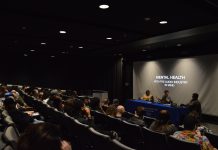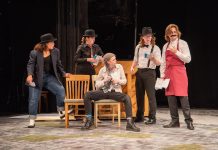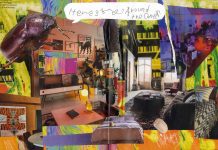Since she was young, Carol Hodson knew that she wanted to be an artist.
“My mother had teased me [about] taking the folding tables in [our home] and making the neighborhood kids come to my art class and showing them how to draw,” Hodson said.
She has been teaching at Webster University for 30 years. She has taught a variety of courses over the years like a First Year Seminar, the Mirror Cracked, BFA Thesis, Design, Painting and Drawing. She has a masters degree in Fine Arts and, as of last May, has a masters degree to be a mental health counselor.
As a counselor at the Student Counseling and Life Development Center she works with students one on one and teaches them how to use art in a therapeutic way.
“I’ve established a studio space that is safe, therapeutic and filled with art possibilities and we talk like therapists do and we make things,” Hodson said. “There’s dance and there’s music and there’s creative writing and through what I’ve learned about art and how much it can heal, show share.”
Her love for art transcends how she views it. Hodson said that she sees art as a way of processing everything that comes her way and as a form of research. She said that it shapes how she teaches, her art, her work as an expressive arts therapist and with being a mother.
Hodson proposed the Creative Strategies class when she first started teaching, and she has taught the class 180 times since then. She said she built the curriculum around what she learn, borrowed, read and invented.
She reinvents the Creative Strategies class every year because she believes that everything changes, including her students.
“The one decision I made when I first started teaching that class is that if I want to model for my students what it means to be truly, truly creative, then I can’t have a curriculum that never changes,” Hodson said. “I have to change what I’m teaching 50 percent [of the coursework] a year because my students are changing. If I gave the same assignment and same readings and then have the same expectations, there’s no way that 28 years later I wouldn’t be bored to death.”
She keeps changing the curriculum to help her be adaptive, and pay attention to who she is communicating with today. Art is the one to do that, Hodson said.
“Art has to know the context, time, culture and who the audience is to be effective,” Hodson said. She said she provides greater puzzles for her students because she offers them the possibility of what art can be.
Jeffery Hughes, an Art History and Criticism professor, is part of a search committee responsible for bringing faculty in. Hughes met Hodson at a conference. Hughes said he was interested in her work and he thinks she makes a great mentor for students.
“She’s crazy… in a good way, she very much cares about the students and she very much cares about teaching and she engages with students individually,” Hughes said.
Hughes said Hodson has a link to a vision that is dynamic and human. He said she confronts people with some of the issues that might be uncomfortable to talk about. Hughes said she imposes on people on the awareness of what it is like to be outside.
“I think Carol is pretty simple in her complexity,” Hughes said.
Hodson said she can never know how her actions will affect someone else but her approach to art is to leave a legacy to students and her daughter for them to see things as a possibility.
Grey Williams is a sophomore Studio Arts major who was in Hodson’s Creative Strategies class and Expressive Arts Studio class. Williams said Hodson is different than any other professors. Hodson, Williams said, pushes the limit of what art is and not just the outcome or the process of art.
“One assignment for drawing class, but I wasn’t in it, she told us that she brought in crickets that were frozen and had the students draw it,” Williams said. “The [crickets] were not dead, they were hibernating, so as they started to thaw out, they started to kick their legs and stuff. Students were like ‘my crickets are moving’ and Hodson said, ‘No, they’re not, they’re dead, just playing along.’ The crickets were jumping around the room and she said, ‘Keep drawing them, they are back to life. Keep drawing them,” Williams said.
Williams said that Hodson was teaching her students in her drawing class that they are going to have different emotions in your drawing because they will constantly change how it looks.
One of the assignments for the Creative Strategies class is an audio assignment where tudents have to go for a walk and talk through whatever they want to talk about on a voice recorder and turn it into art piece.
Williams said the assignment taught them a lot about themselves. Before this class, Williams had never considered thoughts in depth and then turned the assignment into an inner monologue. Williams said students notice more about themselves through this assignment and a lot of what someone is thinking and feeling and Hodson pushes what to do with that.
“She is trying to push students on what they need to be push,” Williams said. “Her teaching style is more individualized, she is vague with a lot of things but it gives you the freedom to take what she tells you and do it how you want to.”
Hodson said she is concerned for students today and the psychological pressure that they have. She said they have the exact problems that she had when she was the same age, but more. Hodson offers her skills to her clients and students but they have to take what they are handed and find a way to act bravely, creatively and innovatively.
“The youth today have so much power and so much potential, they are who we have and I hope they are up to the task,” Hodson said. “I hope they know they are more powerful than they imagine.While I’m here I want to help them live up to that potential a little bit more. I’ll still vote and you guys take over the world.



